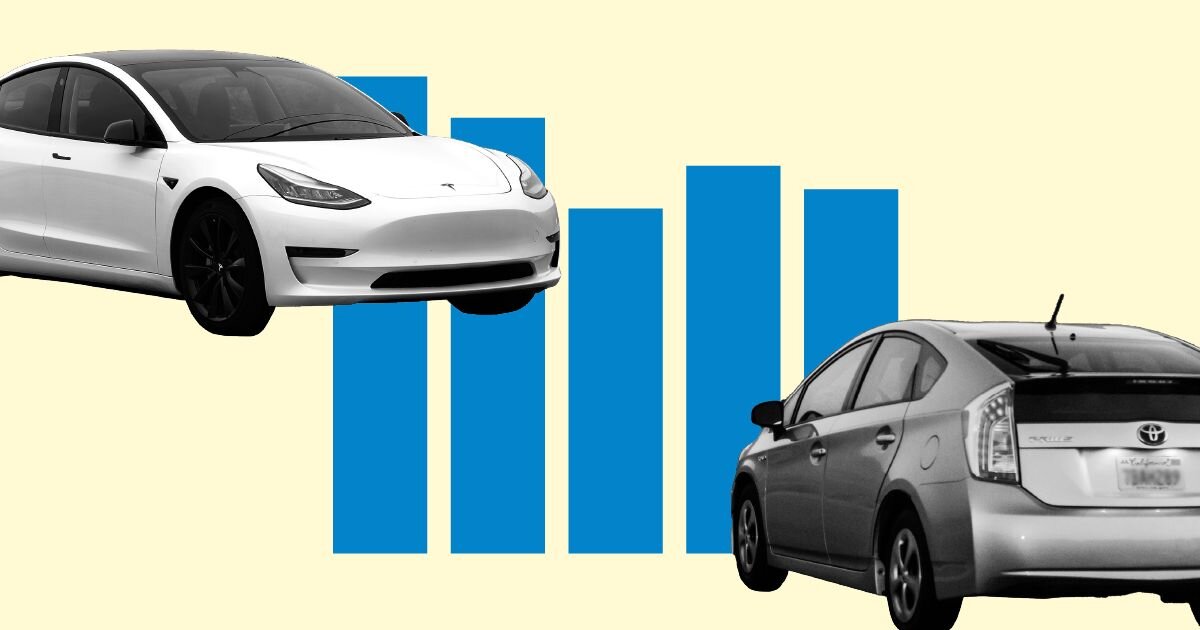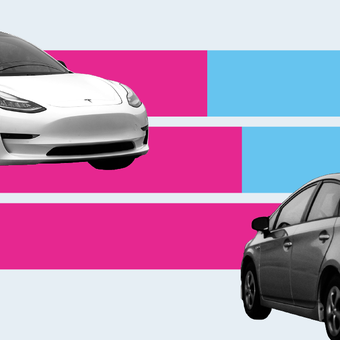There are nearly 100 registered gasoline-powered vehicles for every electric vehicle (EV) in the US. But the growth rate for some alternative-powered vehicles is higher than that of gasoline-powered vehicles, according to the US Department of Energy (DOE).
The number of registered gasoline-powered vehicles increased by 3.5% per 10,000 people from 2020 to 2022 — but the number of electric vehicles on the road grew 135% during the same period.
However, many cars are fueled by alternatives to electricity.
What are alternative fuels?
Alternative fuels generally refer to any fuels other than gasoline or diesel derived from crude oil. Alternative-fuel vehicles could be hybrid-electric or powered by biodiesel, ethanol, propane, natural gas, or hydrogen. Alternative fuels have to meet federal quality and environmental standards.
Subscribe to get unbiased, data-driven insights sent to your inbox weekly.
Alternative fuels are mostly comprised of gaseous fuels (such as hydrogen or propane), alcohols (such as ethanol or methanol), vegetable-derived oils, or electricity, according to the Environmental Protection Agency. Vehicles can run exclusively on alternative fuels, or can have a mixed system of alternative and conventional fuels, like hybrid-electric vehicles.
The three most common alternative fuels in registered vehicles in 2022 were ethanol/flex fuel at nearly 20.9 million, hybrid electric at about 6.3 million, and biodiesel at 2.5 million.
How many vehicles in the US use alternative fuels vs. gasoline?
Thirty-three million vehicles across the US use alternative fuels — that’s 12% of the 282 million light-duty vehicles on the road, according to the Department of Energy.
The states with the largest populations (California, Texas, and Florida) have the highest vehicle counts for six of the 10 vehicle fuel types tracked by the DOE. Analyzing the number of vehicles registered for every 10,000 residents can provide context.
Fuel type use by state
Gasoline is still the most-used fuel in the US, but a combination of fuels are available in various spots throughout the nation. With everything from flex-fuel vehicles in North Dakota to hydrogen-powered cars in California in the US, old and emerging technologies are powering thousands of vehicles. What’s most popular depends on the state.
Electric vehicles
Electric vehicles
Certain vehicle types are more popular by state. Per 10,000 people, California has the most electric (232) and hybrid electric vehicles (388). California also has the most plug-in electric vehicles at 93 per 10,000 people, followed by Vermont at 65.
Hawaii has the second-highest count of electric vehicles per 10,000 people at 137. Washington has the second-most hybrid-electric vehicles per 10,000 people at 347.
Biodiesel
Biodiesel
Wyoming has the most vehicles with this type of fuel per 10,000 people, 329, followed by Montana (296), North Dakota (235), and South Dakota (220).
Ethanol and flex fuel
Ethanol and flex fuel
Flex-fuel vehicles can run on gasoline or a blend of gasoline and ethanol, a type of biofuel made from plant materials. North Dakota has the most flexible-fuel vehicles at 1,200 per 10,000 people.
Compressed Natural Gas
Compressed Natural Gas
Compressed natural gas is a less-common vehicle fuel. It’s considered a renewable biogas, derived from the decomposition of organic matter. Compressed natural gas has been condensed to 1% of its original volume to allow for more storage of fuel per volume. Per 10,000 people, Utah leads with seven compressed natural gas vehicles, followed by Oklahoma at five.
Propane
Propane
Propane is also relatively uncommon as a vehicle fuel source. Utah has two propane-fueled vehicles per 10,000 people, and Arizona has one. These vehicles are mostly used in van or school bus fleets.
Hydrogen
Hydrogen
Hydrogen-powered vehicles are also known as fuel-cell electric vehicles. These vehicles emit water vapor instead of harmful chemicals. Like hybrid-electric vehicles, some have brake systems that capture and store energy in a battery. California is the only state to have any registered hydrogen-powered vehicles (14,900, or about four per 10,000 people).
Diesel
Diesel
Similar to biodiesel trends, diesel vehicles — which can also be biomass-based — are concentrated in the northern US. Wyoming had the most at 1,053 per 10,000 people, followed by Idaho at 701 and Montana at 623.
Gasoline
Gasoline
While not an alternative fuel, gasoline is the most common vehicle fuel in the US. Every state has between about 6,000 and 9,000 gasoline-powered registered vehicles per 10,000 people. The exceptions are New York, which has 5,076 per 10,000, and Washington, DC, which has 4,052 per 10,000.
Where does this data come from?
The Department of Energy provides data visualization tools with data from registration counts derived by the National Renewable Energy Laboratory and Experian Information Solutions.
Learn more about electric vehicles and emissions and the fuel efficiency of vehicles in America, and get the data directly in your inbox by signing up for our email newsletter.
Related population articles
Read data analyses written by the USAFacts team.
Page sources and methodology
All of the data on the page was sourced directly from government agencies. The analysis and final review was performed by USAFacts.
Department of Energy
Vehicle Registration Counts by State
Department of Energy
Alternative Fuels Data Center



